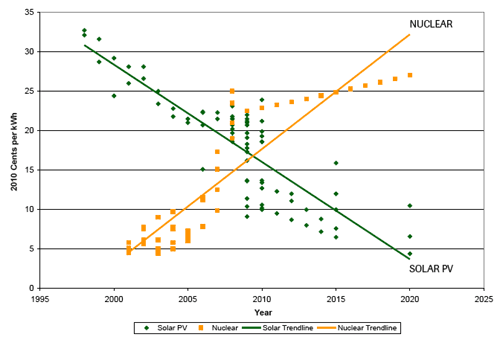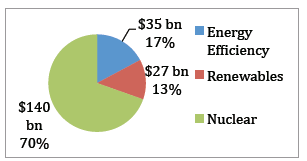Power from renewable sources surpasses N-power for the first time
10 May 2011
For the first time in 2010 total renewable energy from three specific sources - wind turbines, biomass and waste-to-energy plants, and solar power - exceeded the total global nuclear power generation capacity.
 According to the World Nuclear Industry Status Report 2010-2011, published by the Washington-based Worldwatch Institute, the combined global installed capacity of wind turbines at 193 gigawatts (or 193,000 MW), biomass and waste-to-energy plants at 65 GW, and solar power at 43 GW reached 381 GW, exceeded the entire global installed nuclear capacity of 375 GW prior to the Fukushima disaster.
According to the World Nuclear Industry Status Report 2010-2011, published by the Washington-based Worldwatch Institute, the combined global installed capacity of wind turbines at 193 gigawatts (or 193,000 MW), biomass and waste-to-energy plants at 65 GW, and solar power at 43 GW reached 381 GW, exceeded the entire global installed nuclear capacity of 375 GW prior to the Fukushima disaster.
Significantly, the report notes, the annual capacity addition in renewable energy sources have been outpacing the addition of new nuclear power capacity for 15 years. In the United States, alone, the share of renewables in new capacity additions skyrocketed from 2 per cent in 2004 to 55 per cent in 2009, with no new nuclear facility going on-line.
Total investment in renewable energy technologies has been estimated at $243 billion in 2010.
Looking at net additions to the global electricity grid over the last two decades, nuclear power added some 2 GW annually on average during the beginning of this period, compared with a global installed capacity of some 370 GW today.
However, this trend has stagnated or decreased since 2005. Over the same period, global installed wind power capacity increased more than 10 GW annually on average, rising steadily to more than 37 GW in 2009 and 35 GW in 2010. Solar PV has accelerated rapidly in recent years as well.
Net Additions to Global Electricity Grid from New Renewables and Nuclear, 1990–2010 (in GW)

According to the report, nuclear accidents, such as at Fukushima, are worsening many of the problems that nuclear energy is facing. There is "no obvious sign that the international nuclear industry could eventually turn empirically evident downward trend into a promising future", and the Fukushima nuclear disaster is likely to accelerate the decline.
With long lead times of 10 years and more, it will be difficult to maintain, let alone increase, the number of operating nuclear power plants over the next 20 years. Moreover, says the report, it is clear that nuclear power development cannot keep up with the pace of renewable energy commercialisation.
Some analysts consider solar photovoltaic (PV) energy to be competitive with nuclear new-build projects under current real-term prices. The late John O Blackburn of Duke University calculated a ''historic crossover'' of solar and nuclear costs in 2010 in North Carolina. Whereas ''commercial-scale solar developers are already offering utilities electricity at 14 cents or less per kWh,'' Blackburn estimated that a new nuclear plant (none of which is even under construction) would deliver power for 14–18 cents per kWh.
Blackburn also highlighted that though solar electricity is currently supported through tax benefits but is ''fully expected to be cost-competitive without subsidies within a decade.''
Solar and Nuclear Costs: The Historic Crossover

Subsidies for nuclear power
The report notes that nuclear power has been in commercial operation for more than 50 years, yet it continues to receive large direct and indirect subsidies, in part because electricity prices fail to reflect full environmental costs and also because of government guarantees for the final storage or disposal of radioactive waste.
In the United States, even though nuclear and wind technologies produced a comparable amount of energy during their first 15 years (2.6 billion kWh for nuclear versus 1.9 billion kWh for wind), the subsidy to nuclear outweighed that to wind by a factor of over 40 ($39.4 billion versus $900 million).
Even with the demise of new orders for nuclear power and the rise of other energy technologies, nuclear continues to enjoy unparalleled access to government research and development funding.
Analysis from the IEA shows the dominance of nuclear power, both fission and fusion, within R&D budgets - commanding nearly two-thirds of total expenditures in recent decades.
Since 1986, nuclear power has received roughly five times as much government R&D finance as compared with renewables, across the countries of the IEA.
Government Research and Development Budgets across IEA countries 1986–2008 (billion $2008)
 As the estimated cost of nuclear plants continues to escalate, it has become very hard to argue that nuclear power is economic even against renewable options, much less against fossil fuels. Yet, governments continue to support subsidies for nuclear power.
As the estimated cost of nuclear plants continues to escalate, it has become very hard to argue that nuclear power is economic even against renewable options, much less against fossil fuels. Yet, governments continue to support subsidies for nuclear power.
What financiers want
As attempts to finance new nuclear power plants continue, one of the major barriers developers face is obtaining finance. Increasingly, banks and credit rating agencies, not utilities and governments, will determine whether nuclear plants are built.
The ideal solution for financiers remains guaranteed cost-recovery, and it is no surprise that the orders placed in the past three years have been in markets where utilities are mostly publicly owned - China accounts for 26 of the 43 construction starts in the past four years, Russia for six, and Korea for five. All these countries have publicly owned utilities that operate in monopoly markets.
The so-called ''nuclear renaissance'', was based on the claim that a new design of reactors would be offered that was both safer and cheaper than existing designs. Whether this was a delusion on the part of the nuclear industry or a desperate attempt to get one more chance at the promise of cheap power is hard to say, but it was clearly a fallacy.
There is no clear understanding of why cost estimates have escalated so dramatically - sixfold - in the past decade, but it may well be that the process of taking a design from concept to full specification and licensing leads to many more costs than anticipated. The Fukushima accident will likely only ratchet up costs further.
Nuclear power vs renewable energy development
The March 2011 earthquake and tsunami that hit Japan shut down 11 of the country's nuclear reactors, at least six of which are now condemned, but the Japanese Wind Power Association stated, ''there has been no wind facility damage reported by any association member, from either the earthquake or the tsunami.''
Within three weeks of the disaster, Fukushima operator TEPCO, one of the five largest electricity utilities in the world, lost more than three-quarters of its share value, while the Japan Wind Development Company nearly doubled its stock price.
The report notes that traditional energy forecasts project rapid increases in energy demand, driven primarily by the need to fuel Asia's growing economies, particularly in China and to a lesser extent in India.
The International Energy Agency assumes that, if current policies continue, global energy demand will increase 47 per cent by 2035. Based on this scenario, energy consumption in China will effectively triple, whereas in the European Union and the United States it will increase about 4 per cent.
However, the UK Energy Research Centre estimated in 2009 that the average annual rate of decline from oil fields that are past their peak of production is at least 6.5 per cent, while the decline from currently producing fields is at least 4 per cent.
Just maintaining the current level of output would require 3 million barrels a day of new capacity each year, equivalent to the production of Saudi Arabia over three years. And this does not take into account the growing demand from developing countries. The situation for oil is particularly acute but concerns about the availability of other fossil fuels, such as natural gas, in some countries and regions is affecting their price significantly.
Therefore, a new energy system must be based on two pillars.
Firstly, energy efficiency, because meeting the anticipated increase in energy demand at current efficiency levels is not an option given the growth in population and changing consumption patterns.
As the European Commission points out, ''energy savings is one of the most cost effective ways'' to address concerns about climate change and the security of energy supplies.
The second pillar of the new energy system is no or extremely low carbon dioxide emissions. This decarbonization could come from three sources: nuclear power, fossil fuels (using emissions capture and storage), and renewable energy.
Supporters of nuclear power believe that it should play an increasingly important role in this new, highly efficient, zero emissions energy sector, since in their view all low-carbon technologies will be needed. But this claim must be addressed from multiple perspectives.
The building of new nuclear power plants, which is being proposed for the first time in decades in some developed countries, will require further government subsidies or support schemes, such as production tax credits, insurance for cost overruns, and more.
With increasing constraints on public-sector spending, state support for one technology will mean less support available for others.



















